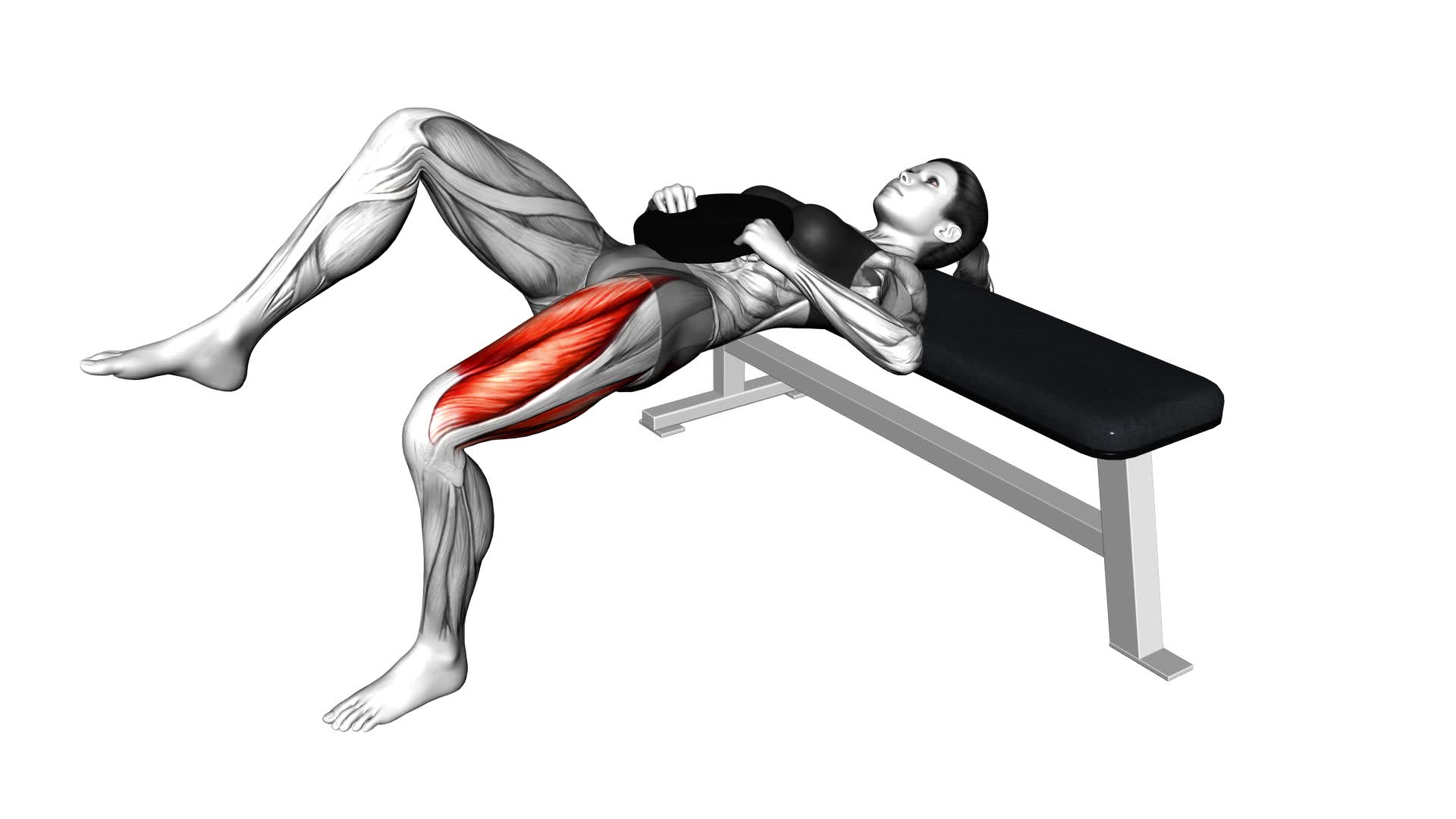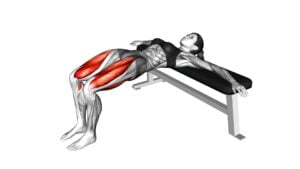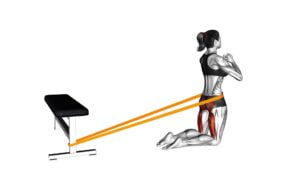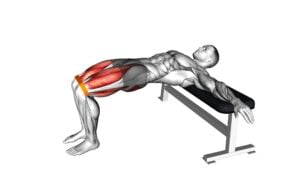Weighted Hip Thrusts (female) – Video Exercise Guide & Tips

Are you looking to strengthen and tone your glutes? Look no further than weighted hip thrusts!
Watch This Exercise Video
In this video exercise guide, we'll show you the proper form, recommended weight, and common mistakes to avoid.
With variations and modifications, you can customize this exercise to suit your fitness level.
Get ready to feel the burn and achieve your booty goals!
Key Takeaways
- Weighted hip thrusts can increase muscle activation in the glutes.
- Proper form and technique are important for maximizing the benefits of weighted hip thrusts.
- Gradually increasing the weight and listening to your body's signals are key for progression.
- Avoiding common mistakes and exploring variations can enhance the effectiveness of weighted hip thrusts.
Benefits of Weighted Hip Thrusts
To maximize your workout routine, incorporating weighted hip thrusts can provide numerous benefits. One of the key benefits of weighted hip thrusts is increased muscle activation. When performing this exercise, your glutes are the primary muscles being targeted. By adding weight to the movement, you're forcing your glute muscles to work harder, resulting in greater activation and stimulation. This increased muscle activation can lead to improved glute strength over time.
Strong glutes are essential for overall lower body strength and stability. Weighted hip thrusts specifically target and strengthen the glute muscles, including the gluteus maximus, gluteus medius, and gluteus minimus. These muscles play a vital role in various movements such as squatting, jumping, and running. By incorporating weighted hip thrusts into your routine, you can develop stronger glutes, which can enhance your performance in other exercises and activities.
In addition to improving glute strength, weighted hip thrusts can also help with developing better posture. Weak glute muscles can contribute to poor posture and lower back pain. By strengthening your glutes through this exercise, you can improve your posture and reduce the risk of experiencing back pain.
Proper Form and Technique
To perform weighted hip thrusts with proper form and technique, you should position yourself on a bench with your back against it. Here are some key tips to ensure you're executing this exercise correctly:
- Engage your core: Before you start, activate your core muscles by pulling your belly button in towards your spine. This will help stabilize your spine and protect your lower back.
- Place the weight correctly: Position a barbell or dumbbell across your hips, ensuring it's securely in place. This added resistance will target your glutes and hamstrings effectively.
- Maintain a neutral spine: Throughout the movement, keep your spine in a neutral position. Avoid arching your back or allowing it to round. This will help prevent injury and maximize muscle activation.
- Drive through your heels: As you lift your hips off the bench, focus on pushing through your heels. This will engage your glutes and hamstrings more effectively, helping you get the most out of each repetition.
Common misconceptions about weighted hip thrusts often revolve around the belief that this exercise is only for women. In reality, both men and women can benefit from incorporating this compound movement into their training routine. Weighted hip thrusts primarily target the glutes, hamstrings, and quadriceps, making them an excellent exercise for building lower body strength and improving overall athletic performance.
Recommended Weight and Progression
Start with a weight that challenges you, but allows you to maintain proper form and complete the desired number of repetitions. The recommended weight for weighted hip thrusts will vary depending on your individual strength and fitness level. It's important to start with a weight that's manageable and gradually increase the load as you become stronger.
When selecting the appropriate weight for weighted hip thrusts, consider using a weight that allows you to perform the exercise with proper form throughout the entire range of motion. If you find that you're struggling to maintain proper technique or if you're unable to complete the desired number of repetitions, it may be necessary to decrease the weight.
On the other hand, if you can easily complete the desired number of repetitions with proper form, it may be time to increase the weight. Gradually increasing the weight over time will help to progressively overload your muscles, leading to strength and muscle gains.
It's important to note that everyone progresses at their own pace, so listen to your body and make adjustments accordingly. If you're unsure about the appropriate weight or how to progress, consider working with a qualified fitness professional who can provide guidance and help you tailor the exercise to your specific needs.
Common Mistakes to Avoid
One common mistake to avoid during weighted hip thrusts is sacrificing proper form for the sake of adding more weight. While it may be tempting to load up the barbell with heavy plates, it's crucial to prioritize correct technique to prevent injury and maximize results.
Here are some important points to keep in mind:
- Importance of glute activation: Before starting the exercise, ensure that you're engaging your glutes properly. Squeeze your glutes at the top of each thrust and focus on using them to drive the movement. This will help you target the correct muscles and avoid overloading other areas.
- How to prevent lower back strain: Lower back strain is a common issue when performing hip thrusts. To avoid this, make sure your spine is in a neutral position throughout the exercise. Keep your core engaged and avoid hyperextending your lower back. Gradually increase the weight to avoid putting excessive stress on your lower back.
- Avoid using momentum: It's essential to perform hip thrusts with controlled movements. Avoid using momentum to thrust the weight up, as this can lead to improper form and reduced effectiveness. Focus on a slow and controlled tempo to engage your glutes effectively.
- Use proper equipment: Using a bench that's too high or too low can affect your form and lead to discomfort. Choose a bench that allows your knees to be at a 90-degree angle when your feet are flat on the ground. This will ensure proper alignment and optimal activation of the glutes.
Variations and Modifications
To add variety to your hip thrust workouts, you can explore different variations and modifications. Variations and progressions can provide a new challenge and target different muscle groups, helping you achieve your fitness goals.
One variation you can try is the single-leg hip thrust. By lifting one leg off the ground, you increase the load on the working leg and engage your glutes and hamstrings even more. This variation is great for improving balance and stability.
Another modification is the banded hip thrust. Using a resistance band around your thighs adds extra resistance throughout the movement, making it more challenging. This variation targets your glutes, hamstrings, and outer thighs.
If you're looking for a more advanced hip thrust variation, you can try the barbell hip thrust. By using a barbell across your hips, you can increase the amount of weight you lift, providing a greater challenge for your glutes and hamstrings.
These variations and modifications offer benefits for different fitness levels. Whether you're a beginner or an advanced lifter, you can find a variation that suits your needs and helps you progress.
Frequently Asked Questions
How Often Should Weighted Hip Thrusts Be Incorporated Into a Workout Routine?
Weighted hip thrusts are a great addition to your workout routine. They can be done 2-3 times a week to see maximum benefits. Incorporating weighted hip thrusts into your routine helps to strengthen your glutes, hamstrings, and core muscles. This exercise also improves your overall lower body strength and power.
Remember to start with lighter weights and gradually increase as you become more comfortable. So go ahead and add weighted hip thrusts to your workout for a stronger, more toned lower body.
Can Weighted Hip Thrusts Help Improve Posture and Reduce Lower Back Pain?
Weighted hip thrusts can be beneficial for improving posture and reducing lower back pain. By incorporating weighted hip thrusts into your workout routine, you can activate and strengthen your glutes, which play a crucial role in maintaining proper posture and spinal alignment.
Additionally, this exercise helps to improve overall strength and stability in your lower body. So, if you're looking to address posture issues and alleviate lower back pain, adding weighted hip thrusts to your routine may be worth considering.
Are There Any Specific Muscles That Weighted Hip Thrusts Target More Than Others?
Weighted hip thrusts target specific muscles more than others.
The exercise primarily activates the gluteus maximus, which is the largest muscle in your buttocks.
It also engages the hamstrings, which are located on the back of your thighs.
Variations of the exercise, such as single-leg hip thrusts or banded hip thrusts, can target different muscles to a greater extent.
Can Weighted Hip Thrusts Be Done Without a Barbell or Weights?
Yes, you can do weighted hip thrusts without a barbell or weights. There are variations of weighted hip thrusts that use bodyweight or alternative equipment like resistance bands or sandbags.
These variations can still provide the benefits of weighted hip thrusts, such as strengthening the glutes, hamstrings, and core muscles. By incorporating different equipment or modifying the exercise, you can still effectively target and challenge these muscle groups without traditional weights.
Are There Any Alternative Exercises That Can Be Done to Target the Same Muscles as Weighted Hip Thrusts?
To target the same muscles as weighted hip thrusts, there are alternative exercises you can try.
Glute bridges and single leg glute bridges are great options. These exercises work your glutes and hamstrings, helping to build strength and tone in those areas.
They can be done without a barbell or weights, making them accessible for anyone.
Incorporating these exercises into your routine can help you achieve your fitness goals and strengthen your lower body.
Conclusion
In conclusion, weighted hip thrusts are a highly effective exercise for strengthening and toning the glutes and hamstrings. By using proper form and gradually increasing the weight, individuals can benefit from improved strength and muscle definition.
It's important to avoid common mistakes and consider variations and modifications to ensure a well-rounded workout. Incorporating weighted hip thrusts into your fitness routine can help you achieve your goals and enhance your overall lower body strength.

Author
Years ago, the spark of my life’s passion ignited in my mind the moment I stepped into the local gym for the first time. The inaugural bead of perspiration, the initial endeavor, the very first surge of endorphins, and a sense of pride that washed over me post-workout marked the beginning of my deep-seated interest in strength sports, fitness, and sports nutrition. This very curiosity blossomed rapidly into a profound fascination, propelling me to earn a Master’s degree in Physical Education from the Academy of Physical Education in Krakow, followed by a Sports Manager diploma from the Jagiellonian University. My journey of growth led me to gain more specialized qualifications, such as being a certified personal trainer with a focus on sports dietetics, a lifeguard, and an instructor for wellness and corrective gymnastics. Theoretical knowledge paired seamlessly with practical experience, reinforcing my belief that the transformation of individuals under my guidance was also a reflection of my personal growth. This belief holds true even today. Each day, I strive to push the boundaries and explore new realms. These realms gently elevate me to greater heights. The unique combination of passion for my field and the continuous quest for growth fuels my drive to break new ground.



